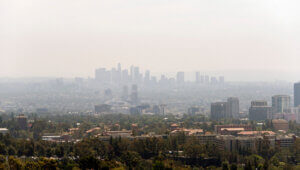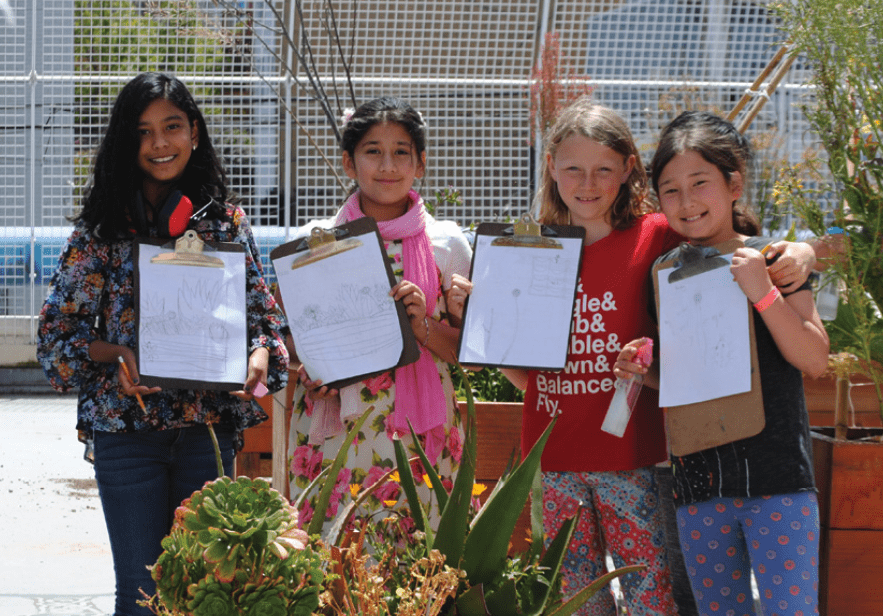Photo by Peter Bennett, taken at Glendale Narrows
With headwaters in the Simi Hills and Santa Susana Mountains, the Los Angeles River runs forty-eight miles to Long Beach, emptying into the Pacific Ocean. During the early years of Los Angeles, the river was the primary source of water that helped the nascent town become a flourishing farming community that grew crops including corn, wheat, grapes, and orchard fruits.
However, many local Los Angeles residents know little about the once turbid river that ran through the heart of the city. “Students usually either don’t know about the river or only think of it as a flood control channel. Some people are told that it’s the sewer leading to the ocean. Most students don’t have a clear picture of what the river is,” says Candice Dickens-Russell, president and CEO of Friends of the Los Angeles River. The river, which once existed in harmony with the local Tongva tribe, played the determining role in Los Angeles’ modern-day location.
By the 1930s, Los Angeles had rapidly expanded onto the flood-prone riverbanks. The city’s unfettered development and the river’s unpredictable character came to a head when a flood ravaged the city and damaged more than 1,500 homes. To prevent future floods from forcing the river over its banks, the U.S. Army Corps of Engineers started enclosing it in a deep concrete channel.
With this enclosure, the river was changed from a biodiverse ecosystem to a freeway for transferring flood water securely and effectively from the mountains to the Pacific Ocean. After more than twenty years of work and 3.5 million barrels of concrete, the vanquished river became an inhospitable drainage ditch that exacerbated growing racial and economic tensions.
The River is Opened For the People
In 1985, a poet named Lewis McAdams took the first step to restore the river in an act of civil disobedience when he cut a hole in the chain link fence that barred access to local citizens. McAdams declared the river “open for the people” and founded Friends of the Los Angeles River (FoLAR).
Founded in 1986, FoLAR is a non-profit organization dedicated to protecting and restoring the natural and historic heritage of the L.A. River. The organization aims to build capacity for communities, students, and future leaders to advocate for nature, climate, and equity on the L.A. River.
The Association for Environmental & Outdoor Education, in partnership with Ten Strands and CAELI, named FoLAR the 2023 Environmental Education Organization of the Year. The award honors exceptional organizations that significantly increase the impact of environmental and outdoor education in California by providing innovative programs and fostering equal access to environmental learning while adhering to evidence-based best practices.
Designing for the Margins
Today, FoLAR is headed by Candice Dickens-Russell, who has worked in environmental education for over twenty years. Candice is also a member of CAELI’s leadership council and a co-chair of CAELI’s Equity Innovation Hub.
 While attending San Francisco State University, Candice began working at the local Boys & Girls Club, where she taught an environmental education program called the Ultimate Journey. Candice’s time at Boys & Girls Club opened her eyes to the need for more students to have access to similar environmental education programs. “With both my background in youth development and my formal education in sustainability and social justice, I knew that my best bet for working in the environmental field was to do something with youth,” Candice says.
While attending San Francisco State University, Candice began working at the local Boys & Girls Club, where she taught an environmental education program called the Ultimate Journey. Candice’s time at Boys & Girls Club opened her eyes to the need for more students to have access to similar environmental education programs. “With both my background in youth development and my formal education in sustainability and social justice, I knew that my best bet for working in the environmental field was to do something with youth,” Candice says.
After graduating with a sustainability and social justice degree, Candice sought environmental education roles that would allow her to combine her experience and education with her passion for the environment. Her decades of leadership in environmental education and equity have included work at organizations such as the Earth Resource Foundation, TreePeople, and DoGoodery.
Throughout her career, Candice has learned to navigate the challenges of working in environmental education by connecting with the CAELI network. “Teaching and managing an environmental education program is hard. Connecting to a larger statewide network of environmental educators in a place like CAELI is important because it helps community-based organizations meet others facing similar challenges,” says Candice.
During her time building connections and networking with California’s climate leaders, Candice learned about FoLAR and its mission to build capacity for communities, students, and future leaders to advocate for nature, climate, and equity on the river. She became passionate about FoLAR’s education programs, which aim to bring students into nature through field trips that educate students about environmental issues and the role of the L.A. River in the region’s ecosystem. As a result, in 2022, Candice joined FoLAR as president and CEO, bringing her years of experience to help expand FoLAR’s mission to encompass both environmental education and a renewed commitment to equity in programming.
“The number one thing to do to ensure equity is to examine your audiences and think about where people are coming from,” says Candice. “This is a method called ‘designing for the margins.’ How do we look at the people who have yet to have these experiences, and how do we create something specifically tailored to meet those needs?”
To help ensure equitable programming, FoLAR partnered with the Los Angeles Unified School District to provide free programs to K–12 public school students, while prioritizing schools that meet the state’s criteria of a “high needs” population, which includes students who are eligible for free and reduced-price lunches, students with disabilities, English language learners, students in foster care, and students experiencing homelessness. These criteria help FoLAR determine the communities living on the margins and identify the needs and obstacles that help inform how they center equity in their work.
FoLAR Today
Today, FoLAR offers free resources that foster critical thinking while encouraging students to learn about the L.A. River’s past, present, and possible future, emphasizing how human behavior impacts our region’s natural and built environments.
One such program is the free standards-based Source to Sea curriculum, which teaches students the L.A. River’s historical significance to the region, explains why it was channelized, and talks about current conditions and plans for reimagining the future.
One of FoLAR’s most significant and long-standing achievements is the L.A. River Cleanup, held annually in April. For over thirty years, this event has brought together thousands of volunteers who work to clean up trash and debris along the river. In 2022, the cleanup removed more than 50,000 pounds of trash from the L.A. River, and FoLAR’s monthly Habitat Restoration Days helped restore and remove invasive species from ninety-five acres of land.
“We weren’t able to go down into the river and do our cleanup in the same way this year because we found out that the endangered Least Bell’s vireo is now nesting in the river,” says Candice. The Least Bell’s vireo is an endangered species of bird that nested in the L.A. River prior to the 1930s. The resurgence of the bird offered hope and encouragement for the decades of stewardship efforts of FoLAR and its partners. FoLAR’s volunteer events, like their annual River CleanUp and monthly Habitat Restoration Days, offer Angelenos along the length of the L.A. River an opportunity to connect with the river, learn about its role in the region, and have agency in improving the overall health of the river ecosystem. Click here to learn more about the L.A. River’s connection to public health.
In addition to its various programs and initiatives, FoLAR is involved in advocacy work to protect and restore the L.A. River. The organization works with local, state, and federal policymakers to promote policies supporting the river’s restoration and protection. FoLAR’s advocacy work includes supporting the L.A. River Master Plan, which outlines a comprehensive river restoration and protection plan.
FoLAR is a vital organization that plays a crucial role in restoring and protecting the L.A. River, as well as providing equitable environmental education opportunities for students. FoLAR has helped raise awareness about the river’s importance and promote its restoration through various programs, initiatives, and advocacy work.
If you’d like to get involved in FoLAR’s work, visit their website or follow them on Instagram, Facebook, Twitter, LinkedIn, YouTube, and Eventbrite to learn more about their programs and volunteer opportunities. You can also register and become a member.







